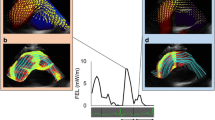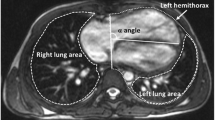Abstract
Objectives
Flow through the proximal pulmonary arteries (PAs) of patients with repaired Tetralogy of Fallot (TOF) is known to be highly disordered and associated with significant regurgitation. The purpose of this study was to evaluate 4D-Flow MRI–derived viscous energy loss \( \Big({E}_L^{\prime } \))—as a result of non-efficient flow propagation, and relate this parameter to standard right ventricular (RV) size and function markers in patients with repaired TOF.
Methods
Thirty-five patients with TOF and 14 controls underwent comprehensive 4D-Flow MRI evaluation for qualitative flow analysis and to calculate \( {E}_L^{\prime } \) in the main and right pulmonary arteries. Sampled \( {E}_L^{\prime } \) indices were correlated with the MRI-derived RV size and functional indices.
Results
All patients with TOF exhibited abnormal, supra-physiologic helical/vortical formations in the PAs. Patients with TOF had significantly increased peak systolic \( {E}_L^{\prime } \) (8.0 vs 0.5 mW, p < 0.001), time-averaged \( {E}_L^{\prime } \) (2.5 vs. 0.2 mW, p < 0.001), and peak systolic \( {E}_L^{\prime } \) indexed to stroke volume (0.082 vs. 0.012 mW/mL, p < 0.001). \( {E}_L^{\prime } \) indexed to stroke volume correlated with the RV end-diastolic volume (R = 0.68, p < 0.001), end-systolic volume (R = 0.62, p < 0.001), ejection fraction (R = −0.45, p = 0.002), and cardiac index (R = 0.45, p = 0.002). The mean estimated energy loss due to \( {E}_L^{\prime } \) with regard to input RV mechanical power was 4.7%.
Conclusion
This study demonstrates that patients with repaired TOF have highly abnormal flow conduction through the PAs which result into extensive viscous energy loss. This significant flow-mediated energy loss is associated with the RV volume and function, and might represent considerable loss of mechanical power generated by each cardiac cycle. Future studies are required to assess whether the abnormal flow conduction adds to the RV afterload and remodeling.
Key points
• Abnormal flow patterns through proximal pulmonary arteries in patients with TOF are associated with excessive viscous energy loss.
• Inefficient flow conduction is associated with the RV dilation and reduced function and might contribute to the RV adaptive remodeling.





Similar content being viewed by others
Abbreviations
- 4D-Flow MRI:
-
Four-dimensional flow magnetic resonance imaging
- E L ′ :
-
Viscous energy loss
- LPA:
-
Left pulmonary artery
- MPA:
-
Main pulmonary artery
- PA:
-
Pulmonary artery
- RPA:
-
Right pulmonary artery
- RV:
-
Right ventricle
- TOF:
-
Tetralogy of Fallot
References
François CJ, Srinivasan S, Schiebler ML et al (2012) 4D cardiovascular magnetic resonance velocity mapping of alterations of right heart flow patterns and main pulmonary artery hemodynamics in tetralogy of Fallot. J Cardiovasc Magn Reson 14:1–12. https://doi.org/10.1186/1532-429X-14-16
Sjöberg P, Bidhult S, Bock J et al (2018) Disturbed left and right ventricular kinetic energy in patients with repaired tetralogy of Fallot: pathophysiological insights using 4D-flow MRI. Eur Radiol. https://doi.org/10.1007/s00330-018-5385-3
Barker AJ, Markl M, Bürk J et al (2012) Bicuspid aortic valve is associated with altered wall shear stress in the ascending aorta. Circ Cardiovasc Imaging 5:457–466. https://doi.org/10.1161/CIRCIMAGING.112.973370
Mahadevia R, Barker AJ, Schnell S et al (2014) Bicuspid aortic cusp fusion morphology alters aortic three-dimensional outflow patterns, wall shear stress, and expression of aortopathy. Circulation 129:673–682. https://doi.org/10.1161/CIRCULATIONAHA.113.003026
Guzzardi DG, Barker AJ, van Ooij P et al (2015) Valve-related hemodynamics mediate human bicuspid aortopathy. J Am Coll Cardiol 66:892–900. https://doi.org/10.1016/j.jacc.2015.06.1310
Von Knobelsdorff-Brenkenhoff F, Karunaharamoorthy A, Trauzeddel RF et al (2016) Evaluation of aortic blood flow and wall shear stress in aortic stenosis and its association with left ventricular remodeling. Circ Cardiovasc Imaging 9:1–10. https://doi.org/10.1161/CIRCIMAGING.115.004038
Schäfer M, Kheyfets VO, Schroeder JD et al (2016) Main pulmonary arterial wall shear stress correlates with invasive hemodynamics and stiffness in pulmonary hypertension. Pulm Circ 6. https://doi.org/10.1086/685024
Friesen RM, Schäfer M, Dunbar Ivy D et al (2019) Proximal pulmonary vascular stiffness as a prognostic factor in children with pulmonary arterial hypertension. Eur Heart J Cardiovasc Imaging 20:209–217. https://doi.org/10.1093/ehjci/jey069
Schäfer M, Ivy DD, Abman SH et al (2019) Differences in pulmonary arterial flow hemodynamics between children and adults with pulmonary arterial hypertension as assessed by 4D-flow CMR studies. Am J Physiol Circ Physiol 316:H1091–H1104. https://doi.org/10.1152/ajpheart.00802.2018
Gatzoulis MA, Balaji S, Webber SA et al (2000) Risk factors for arrhythmia and sudden cardiac death late after repair of tetralogy of Fallot: a multicentre study. Lancet 356:975–981. https://doi.org/10.1016/S0140-6736(00)02714-8
Apitz C, Webb GD, Redington AN (2009) Tetralogy of Fallot. Lancet 374:1462–1471. https://doi.org/10.1002/9781118742440.ch22
Dyverfeldt P, Bissell M, Barker AJ et al (2015) 4D flow cardiovascular magnetic resonance consensus statement. J Cardiovasc Magn Reson 17:72. https://doi.org/10.1186/s12968-015-0174-5
Geiger J, Markl M, Jung B et al (2011) 4D-MR flow analysis in patients after repair for tetralogy of Fallot. Eur Radiol 21:1651–1657. https://doi.org/10.1007/s00330-011-2108-4
Robinson JD, Rose MJ, Joh M et al (2018) 4-D flow magnetic-resonance-imaging-derived energetic biomarkers are abnormal in children with repaired tetralogy of Fallot and associated with disease severity. Pediatr Radiol:1–10. https://doi.org/10.1007/s00247-018-4312-8
Barker AJ, van Ooij P, Bandi K et al (2013) Viscous energy loss in the presence of abnormal aortic flow. Magn Reson Med 628:620–628. https://doi.org/10.1002/mrm.24962
Kamphuis VP, Elbaz MSM, Van Den Boogaard PJ et al (2019) Disproportionate intraventricular viscous energy loss in Fontan patients: analysis by 4D flow MRI. Eur Heart J Cardiovasc Imaging 20:323–333. https://doi.org/10.1093/EHJCI/JEY096
Schafer M, Barker AJ, Jaggers J, et al (2019) Abnormal aortic flow conduction is associated with increased viscous energy loss in patients with repaired tetralogy of Fallot. Eur J Cardio-thoracic Surg 0:1–8. https://doi.org/10.1093/ejcts/ezz246
Schäfer M, Barker AJ, Kheyfets V et al (2017) Helicity and vorticity of pulmonary arterial flow in patients with pulmonary hypertension: quantitative analysis of flow formations. J Am Heart Assoc 6:e007010. https://doi.org/10.1161/JAHA.117.007010
Bürk J, Blanke P, Stankovic Z et al (2012) Evaluation of 3D blood flow patterns and wall shear stress in the normal and dilated thoracic aorta using flow-sensitive 4D CMR. J Cardiovasc Magn Reson 14:84. https://doi.org/10.1186/1532-429X-14-84
Schäfer M, Browne LP, Morgan GJ et al (2018) Reduced proximal aortic compliance and elevated wall shear stress after early repair of tetralogy of Fallot. J Thorac Cardiovasc Surg 156:2239–2249. https://doi.org/10.1016/j.jtcvs.2018.08.081
Mercer-Rosa L, Yang W, Kutty S et al (2012) Quantifying pulmonary regurgitation and right ventricular function in surgically repaired tetralogy of Fallot a comparative analysis of echocardiography and magnetic resonance imaging. Circ Cardiovasc Imaging 5:637–643. https://doi.org/10.1161/CIRCIMAGING.112.972588
Friesen RM, Scha M, Ivy DD et al (2018) Proximal pulmonary vascular stiffness as a prognostic factor in children with pulmonary arterial hypertension. Eur Heart J Cardiovasc Imaging 20(2):209–217 https://doi.org/10.1093/ehjci/jey069
Schäfer M, Ivy DD, Barker AJ et al (2016) Characterization of CMR-derived haemodynamic data in children with pulmonary arterial hypertension. Eur hear J – Cardiovasc Imaging. https://doi.org/10.1093/ehjci/jew152
Hirtler D, Garcia J, Barker AJ, Geiger J (2016) Assessment of intracardiac flow and vorticity in the right heart of patients after repair of tetralogy of Fallot by flow-sensitive 4D MRI. Eur Radiol 26:3598–3607. https://doi.org/10.1007/s00330-015-4186-1
Sjöberg P, Töger J, Hedström E et al (2018) Altered biventricular hemodynamic forces in patients with repaired tetralogy of Fallot and right ventricular volume overload because of pulmonary regurgitation. Am J Physiol Circ Physiol 315:H1691–H1702. https://doi.org/10.1152/ajpheart.00330.2018
Fredriksson A, Trzebiatowska-Krzynska A, Dyverfeldt P et al (2018) Turbulent kinetic energy in the right ventricle: potential MR marker for risk stratification of adults with repaired tetralogy of Fallot. J Magn Reson Imaging 47:1043–1053. https://doi.org/10.1002/jmri.25830
Jeong D, Anagnostopoulos PV, Roldan-Alzate A et al (2015) Ventricular kinetic energy may provide a novel noninvasive way to assess ventricular performance in patients with repaired tetralogy of Fallot. J Thorac Cardiovasc Surg 149:1339–1347. https://doi.org/10.1016/j.jtcvs.2014.11.085
Dyverfeldt P, Hope MD, Tseng EE, Saloner D (2013) Magnetic resonance measurement of turbulent kinetic energy for the estimation of irreversible pressure loss in aortic stenosis. JACC Cardiovasc Imaging 6:64–71. https://doi.org/10.1016/j.jcmg.2012.07.017
Fredriksson A, Trzebiatowska-Krzynska A, Dyverfeldt P et al (2018) Turbulent kinetic energy in the right ventricle: potential MR marker for risk stratification of adults with repaired tetralogy of Fallot. J Magn Reson Imaging 47:1043–1053. https://doi.org/10.1002/jmri.25830
Binter C, Gülan U, Holzner M, Kozerke S (2016) On the accuracy of viscous and turbulent loss quantification in stenotic aortic flow using phase-contrast MRI. Magn Reson Med 76:191–196. https://doi.org/10.1002/mrm.25862
Chen CA, Dusenbery SM, Valente AM et al (2016) Myocardial ECV fraction assessed by CMR is associated with type of hemodynamic load and arrhythmia in repaired tetralogy of Fallot. JACC Cardiovasc Imaging 9:1–10. https://doi.org/10.1016/j.jcmg.2015.09.011
Schäfer M, Wilson N, Ivy DD et al (2018) Noninvasive wave intensity analysis predicts functional worsening in children with pulmonary arterial hypertension. Am J Physiol Circ Physiol 315:H968–H977. https://doi.org/10.1152/ajpheart.00227.2018
Geva T (2013) Indications for pulmonary valve replacement in repaired tetralogy of Fallot: the quest continues. Circulation 128:1855–1857. https://doi.org/10.1161/CIRCULATIONAHA.113.005878
Dyverfeldt P, Hope MD, Tseng EE, Saloner D (2013) Magnetic resonance measurement of turbulent kinetic energy for the estimation of irreversible pressure loss in aortic stenosis. JACC Cardiovasc Imaging 6:64–71. https://doi.org/10.1016/j.jcmg.2012.07.017
Strecker C, Harloff A, Wallis W, Markl M (2012) Flow-sensitive 4D MRI of the thoracic aorta: comparison of image quality, quantitative flow, and wall parameters at 1.5 T and 3 T. J Magn Reson Imaging 36:1097–1103. https://doi.org/10.1002/jmri.23735
Funding
This study was supported by a generous gift from the Rady Family Foundation and Jayden DeLuca Foundation. AJB is supported in part by NIH K25HL119608 and R01HL133504.
Author information
Authors and Affiliations
Corresponding author
Ethics declarations
Guarantor
The scientific guarantor of this publication is Michal Schäfer.
Conflict of interest
The authors of this manuscript declare no relationships with any companies, whose products or services may be related to the subject matter of the article.
Statistics and biometry
One of the authors has significant statistical expertise.
Informed consent
Written informed consent was waived by the Institutional Review Board.
Ethical approval
Institutional Review Board approval was obtained.
Study subjects or cohorts overlap
Some study subjects or cohorts have been previously reported in
1. Schäfer M, Browne LP, Jaggers J, et al (2020) Abnormal left ventricular flow organization following repair of tetralogy of Fallot. J Thorac Cardiovasc Surg.
2. Schäfer M, Browne LP, Morgan GJ, et al (2018) Reduced proximal aortic compliance and elevated wall shear stress after early repair of tetralogy of Fallot. J Thorac Cardiovasc Surg 156:2239–2249.
Methodology
-
retrospective
-
case-control study
-
performed at one institution
Additional information
Publisher’s note
Springer Nature remains neutral with regard to jurisdictional claims in published maps and institutional affiliations.
Rights and permissions
About this article
Cite this article
McLennan, D., Schäfer, M., Barker, A.J. et al. Abnormal flow conduction through pulmonary arteries is associated with right ventricular volume and function in patients with repaired tetralogy of Fallot: does flow quality affect afterload?. Eur Radiol 33, 302–311 (2023). https://doi.org/10.1007/s00330-022-09017-6
Received:
Revised:
Accepted:
Published:
Issue Date:
DOI: https://doi.org/10.1007/s00330-022-09017-6




